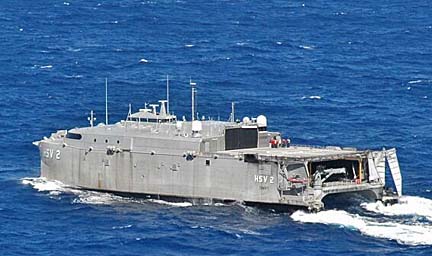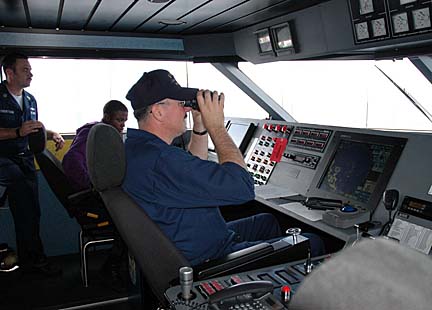
The Navy's experimental, all-aluminum twin-hull catamaran -- HSV-2 Swift -- is now being used off Bellows Air Force Station in a RIMPAC mine-clearing exercise.
Navy’s fast catamaran
excels at mine clearingThe novel warship plies Hawaii
waters for RIMPAC exercises
TEN MILES OFF WAIMANALO >> During the 1991 Persian Gulf War, most of the damage on the high seas was by mines -- cheap and effective defensive weapons.
The HSV-2 Swift
The high-speed vessel employs a unique design to reach speeds of more than 45 knots (51 mph).Length: 326 feet
Width: 87 feet
Deepest point: 13 feet
Crew: Five officers, 25 sailors
Propulsion: Caterpillar marine diesel engines
Mines were responsible for "knocking out three U.S. warships," said Cmdr. Jon Lux, commanding officer of Mine Countermeasures Squadron 3.
"If you go back and look through history, more damage has been done to ships via mines than any other means of anti-surface warfare -- missiles from aircraft and submarines," Lux said yesterday.
Because of the threat from mines, one of the key components in this year's Rim of the Pacific, or , naval war games is a mine-sweeping and clearing exercise involving for the first time one of the Navy's experimental wave-piecing vessels, the HSV-2 Swift.
The all-aluminum twin-hull catamaran is one of three leased by the military. (The Navy has two and the Army one.) The 326-foot Swift is leased by the Military Sealift Command from Bollinger/Incat USA LLC, of Lockport, La.
The HSV-2 is carrying 70 of the 150 sailors assigned to the Navy Special Operations Team 1 in San Diego, according to its commanding officer, Cmdr. Tony Rodgers. Twenty-four of his crew are Navy divers, Rodgers said, with another 15 divers from the Australian navy.
His unit also employs mine-seeking dolphins, but they were not brought to the islands for this RIMPAC.
During last year's Iraq war operations, nine dolphins were used in the harbors near Umn Qasar, near the Pakistani border, Rodgers said, to clear the way for ships carrying humanitarian supplies.
"We found a lot of mines in warehouses and patrol boats, but none in the harbors," Rodgers said.
Part of the RIMPAC mine-clearing exercise is in the waters off of Molokai, Lanai and Oahu with the channel playing the role of a vital shipping lane. Lux said two minesweepers, USS Avenger and USS Defender, and one from Canada, HMS Brandon, are involved in that operation.
Another part of the exercise, which involves the Swift, is clearing an assault lane to the beaches at Bellows Air Force Station for a Marine Corps amphibious landing next week.
Chief Petty Officer Mike Fallis, Swift's officer of the deck, uses his binoculars to watch for other ships while Petty Officer George Robertson, standing, instructs Petty Officer Roger Altson on his duties as engineering officer of the watch.
For this exercise off Bellows, the Navy is testing several "unmanned autonomous vehicles" -- torpedo-looking devices that take pictures of the water and the ocean bottom.Lt. Cmdr Kevin Morrison, Swift's executive officer, said the commercial versions of the twin-hulled HSV-2 are used as ferries in Europe with its bottom deck used to carry cars and trucks.
The Navy compares the Swift to a larger version of the Army's new Stryker eight-wheeled combat vehicle, which can be configured from an ambulance to a troop carrier to a special reconnaissance vehicle.
Cmdr. Mark Sakaguchi, the Swift's commanding officer, said the catamaran can easily move from its role as supporting mine-sweeping operations to anti-submarine warfare by bringing aboard modular electronics packages needed for a specific mission.
A commercial computer system provides all of the Swift's navigation and steering capabilities, Morrison said.
"There are three people on the bridge at any given time. That's all we need to drive the ship," he said. A standard Navy ship requires eight to 10 sailors on the bridge.
The officer of the deck sits in the center seat on the bridge and also serves as the driver, using the navigation system.
The navigation-steering system is designed to have no paper charts, Morrison added. "The Swift is the only ship in the Navy currently authorized to run the paperless chart system."
Sakaguchi can monitor the operations of the Swift from the Combat Information Center using a network of cameras.

